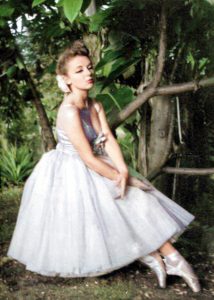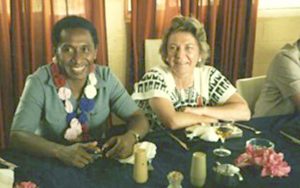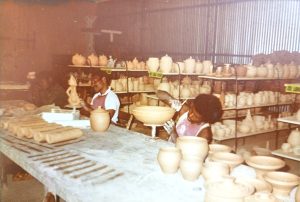Muriel Larner MBE—a Mother’s Legacy
Rosalie Everest
Rosalie Everest plans to return to the Eastern Highlands of PNG in June 2024 with her mother’s ashes. This is Part 1 of a two-part story.
Before my mother, Muriel Larner, née MacGowan, passed away in 2019, she gave me her diaries, newspaper cuttings and incomplete memoirs, and asked me to tell her story. This is a daunting task as my mother, born in 1929 in Rabaul, was evacuated from the volcano eruption there, and then again on the eve of the Japanese invasion in 1941. She returned after WWII to Port Moresby where she married Wally Larner, my father.
In 1957 my parents Muriel and Wally moved to the Highlands to establish a coffee plantation. My father’s death in 1967 left my mother with a struggling plantation to run and two children to raise. She not only successfully managed the plantation but went on to establish the Eastern Highlands Culture Centre in Kainantu, for which she was later honoured with an MBE for ‘services to culture’.
When Muriel and Wally arrived at Arau plantation in the Eastern Highlands, they had a four-year-old daughter and a four-week-old baby (me). Muriel’s ball gowns, the fox fur, evening bags and stiletto heels, from a glamorous pre-marriage life in Port Moresby, were soon relegated to a large Chinese camphorwood ‘dress-up’ box for my sister, Bronwyn, and me. Donning trousers, shirts and sensible shoes, the plantation Missis Muriel, supported her husband by establishing and running several village trade stores, training, supervising and working with the labour lines planting and pruning coffee trees and providing what aid she could for sick or injured villagers.

Muriel dancing under a frangipani tree after her return to Port Moresby in 1946. Photo taken by Muriel’s father William MacGowan
My parents persevered through physical and financial hardships but revelled in the joys of family life at Arau. Muriel gave correspondence lessons to my sister and me for the first five years of our primary education. Bronwyn left for boarding school in 1964, and I was due to follow when I turned ten, but in the middle of the night of 16th July 1967 my father suffered a massive heart attack. Muriel switched on the generator and sent word to the aid post orderly in the village.
He ran to Arau from the village and tried unsuccessfully to revive my father. When the reality of my father’s death had sunk in, Muriel and I could only turn off the generator and wait in the dark for the sun to come up. The next morning, she sent a telegram on the two-way radio to my sister at boarding school and, as the news spread at Arau, plantation workers and local villagers surrounded the house, wailing for the loss of Masta Wally.
Muriel found herself a widow at the age of 37, on an isolated debt-ridden plantation with two daughters to support and educate. Her friends encouraged her to pack up and go to Australia so she could put us into a day school in Queensland. They couldn’t believe that a single white woman in her circumstances would remain in the Territory. But Muriel never faltered in her determination to stay in the place of her birth, the land of her childhood and her early adulthood up until her marriage.
Living a suburban life in Australia, a country she never considered home, was not an option. Muriel simply decided that she could run Arau on her own, despite being told that plantation workers ‘wouldn’t take orders from a woman’. Muriel wrote in her diary: ‘My staff were wonderful, and funnily enough, were proud that they had a woman boss.’
Over the next few years, in addition to running the plantation with her loyal foreman, Gegesa Simalobe, Muriel rekindled an earlier interest in the arts. Due to a profound hearing loss from childhood, which caused her to wear bulky hearing aids, after her evacuation from Rabaul my mother completed her education at art school in Adelaide. Thus, she became proficient in sculpture, drawing, design, drafting, classical ballet and water ballet. While digging drains on Arau, Muriel discovered a very rich seam of high-quality clay suitable for pottery, so she resumed her hobbies of ceramic sculpture and hand-built pottery.
Graham Gilmore, an old friend and an accomplished potter, encouraged Muriel in her artistic pursuits and helped her install a kiln and pottery wheel. Muriel then took on some young apprentices from the local community teaching them pottery and screen-printing. Our guest house was converted into a bustling art studio, which was the precursor of the Eastern Highlands Cultural Centre in Kainantu. Muriel and her band of protégés, which included young Tane and Pa’a, were soon shipping their pottery and screen-printed items to towns.
In 1973, the Department of Commerce and Business Development heard of the success of Muriel’s creative enterprise and made an initial offer of a job for her to be based in nearby Kainantu town. Promises were made that the provincial government would build a workshop to enable Muriel to train more potters and printers. She didn’t agree until the following year, after employing a plantation manager, which made it possible for her to move the craft enterprise to Kainantu, where she purchased a group of houses close together.
One of Muriel’s houses became the Kainantu Potteries workshop and showroom, and Muriel lived in the house behind. The potters and their families resided in basic accommodation at the back of Muriel’s home. However, by the end of 1974, the government promise of a workshop, a wage for Muriel, and housing for the staff, had not eventuated. Muriel continued to use her limited resources to accommodate, support, and provide transport for the potters.
She then founded Eastern Highlands Prints where more young trainees learnt printing and dressmaking. Both concerns were very successful, providing the trainees with combinations of a piece-rate income, an hourly wage and shares in the business, with career paths. Muriel’s diaries illustrate the damaging social impacts of alcohol abuse, petty pilfering, regional conflicts, domestic violence and general law and order problems with which she had to contend in Kainantu town.

Then PNG Prime Minister, Sir Julius Chan, with Muriel. (Photo taken at Kainantu Lodge, August 1980, possibly by Barry Korin when Sir Julius visited the Centre)
During this period, Muriel continued to assist her manager at Arau, with fortnightly trips over muddy roads to inspect the coffee and factory and carry out stocktakes at the trade stores. It was a gruelling, busy life but Muriel was devoted to developing her unquestionably talented trainees and to keep the plantation running.
She also held pottery lessons at Kainantu High School and invited local Kainantu children to join her at the Council Chambers for weekly ballet lessons, for which she provided each child with a freshly laundered pair of green and white striped football socks.
It was five years before the Government made good on their promise to properly assist Muriel and her trainees and artisans. The Office of Business Development did, however, in 1976 begin to source and support a succession of overseas volunteer technical officers, all of whom made significant contributions to the enterprise’s development. The potters, printers, seamstresses and volunteers made increasingly loud complaints about the unfulfilled government promises until, finally in 1979, a vacant block of land next to a block with a tin shed was purchased as the site for the long-proposed craft centre.
Paul Frame, architect of the Raun Raun Theatre in Goroka, arrived to draw up plans for the venture. Kainantu Potteries and Eastern Highlands Prints moved into the tin shed and the building of staff quarters began. The vision of an elegant, timber, purpose-built cultural centre, with a soaring roof of wood shingles and a colonnade of carved pillars, started to take shape.
By the time it was opened to great acclaim in November 1981, the Cultural Centre had already expanded its operations to include spinning, weaving and metal sculpture. A steady stream of visitors arrived at the centre seven days a week, through spectacular doors crafted by the renowned metal sculptor Ruki Fame. Muriel’s dream was finally a reality!
Due to Muriel’s life-long hearing disability, she became inspired when she learned that 1982 was to be the UN Year of the Disabled. She immediately launched a campaign to recruit disabled trainees to work at the Cultural Centre. So many applicants came forward that several had to be turned away. There was Ia-pas (a hearing-disabled person whom the other potters called by that name), and Ai-pas (as per a vision-impaired person addressed by other potters), along with recruits disabled in their legs and arms.
It was an extraordinary initiative as these workers became very skilled and successful under the tutelage of able-bodied potters. Hearing-disabled and non-verbal Tayas was a particularly gifted and prolific potter. Years later, when Muriel was no longer running the Centre, Tayas did not trust anyone other than her to speak and advocate on his behalf.
When interviewed in 1982 by Hollie Smith 1 about this feature of the Cultural Centre’s operations, Muriel explained that the infectious laughter and good humour of this band of disabled potters brought a newfound light-heartedness to the workshop, as everyone admired their courage and determination.
Other initiatives at the centre included the encouragement of local craftsmen and women to bring artefacts and crafts to sell directly to the public. A coffee shop and a small museum of precious artefacts from the Kainantu area were also installed. The Eastern Highlands Cultural Centre flourished, becoming the icon of Kainantu, the ‘Gateway to the Highlands’.
So now I must prepare for my pilgrimage back to Arau, Kainantu and the Cultural Centre, to lay my mother Muriel to rest and to see what memories of her legacy remain today. I will document my journey and I plan to write a follow-up article on my return.
(1) Hollie Smith published an article ‘Disabled Six Brighten up Pottery Shop’ in PNG’s Post Courier. Rosalie contacted Hollie but she cannot remember the date of the news report.



